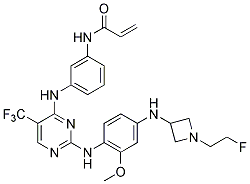| Cas No.: | 1375465-09-0 |
| Chemical Name: | 2-Propenamide,N-[3-[[2-[[4-[[1-(2-fluoroethyl)-3-azetidinyl]amino]-2-methoxyphenyl]amino]-5-(trifluoromethyl)-4-pyrimidinyl]amino]phenyl]- |
| Synonyms: | CNX2006; CNX 2006 |
| SMILES: | C=CC(NC1=CC=CC(NC2=NC(NC3=CC=C(NC4CN(CCF)C4)C=C3OC)=NC=C2C(F)(F)F)=C1)=O |
| Formula: | C26H27F4N7O2 |
| M.Wt: | 545.53 |
| Purity: | >98% |
| Sotrage: | 2 years -20°C Powder, 2 weeks 4°C in DMSO, 6 months -80°C in DMSO |
| Description: | CNX-2006 is a mutant-selective and irreversible EGFR inhibitor with an IC50 below 20 nM for EGFRT790M. |
| Target: | EGFRT790M:20 nM (IC50) EGFRL858R/T790M |
| In Vitro: | CNX-2006 inhibits EGFR-T790M cells growth up to 1000-fold more compared to wild-type EGFR cells. EGFR inhibition is observed in cells harbouring the T790M mutation at IC50 values below 20 nM after 1 hour exposure to the drug. CNX-2006 also significantly reduces the volume of tumor spheres derived from H1975 cells[1]. CNX-2006 exhibits specificity and potent activity against T790M. The drug also shows activity against uncommon EGFR mutations including G719S, L861Q, an exon 19 insertion mutant (I744-K745insKIPVAI), and T854A, but not an exon 20 insertion (H773-V774HVdup). In an in vitro resistance model, CNX-2006 significantly inhibits the emergence of resistant cells. Chronic exposure to escalating doses of CNX-2006 fails to select for and/or enhance T790M-mediated resistance using PC-9 or HCC827 cells (both harboring exon 19 deletions), or PC-9/ER and HCC827/ER cells with existing T790M and resistance to erlotinib[2]. |
| References: | [1]. Galvani E, et al. Abstract 3244: Role of epithelial-mesenchymal transition (EMT) in sensitivity to CNX-2006, a novel mutant-selective EGFR inhibitor which overcomes in vitro T790M-mediated resistance in NSCLC. CNX-2006, a novel mutant-selective EGFR inhibitor which overcomes in vitro T790M-mediated resistance in NSCLC. [abstract]. In: Proceedings of the 104th Annual Meeting of the American Association for Cancer Research; 2013 Apr 6-10; Ishington, DC. Philadelphia (PA): AACR; Cancer Res 2013;73(8 Suppl):Abstract nr 3244. doi:10.1158/1538-7445.AM2013-3244 [2]. Ohashi K, et al. Abstract 2101A: CNX-2006, a novel irreversible epidermal growth factor receptor (EGFR) inhibitor, selectively inhibits EGFR T790M and fails to induce T790M-mediated resistance in vitro. [abstract]. In: Proceedings of the 104th Annual Meeting of the American Association for Cancer Research; 2013 Apr 6-10; Ishington, DC. Philadelphia (PA): AACR; Cancer Res 2013;73(8 Suppl):Abstract nr 2101A. doi:10.1158/1538-7445.AM2013-2101A |

 To enhance service speed and avoid tariff delays, we've opened a US warehouse. All US orders ship directly from our US facility.
To enhance service speed and avoid tariff delays, we've opened a US warehouse. All US orders ship directly from our US facility.




















